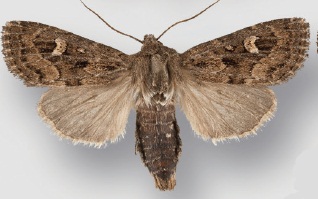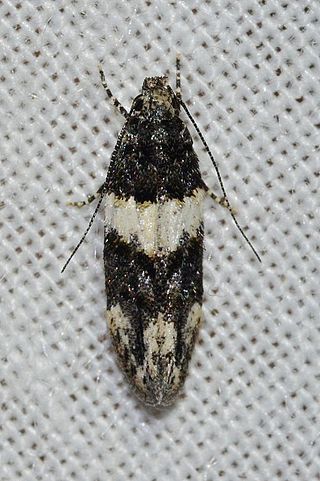
Pandemis heparana, the dark fruit-tree tortrix or apple brown tortrix, is a moth of the family Tortricidae.

Nomophila noctuella, the rush veneer, is a species of moth of the family Crambidae.
Geshna is a monotypic moth genus of the family Crambidae described by Harrison Gray Dyar Jr. in 1906. It contains only one species, Geshna cannalis, the lesser canna leafroller, described by Altus Lacy Quaintance in 1898. It is found in North America, where it has been recorded from Florida, Mississippi, South Carolina, North Carolina and Tennessee. It has also been recorded from Costa Rica and Cuba.
Hellula phidilealis, the cabbage budworm moth, is a moth of the family Crambidae. It is found in tropical and subtropical America. From the southern United States, north in the east to North Carolina, south through southwestern Mexico to northern South America, including several islands in the Caribbean.
Caloptilia glutinella is a moth of the family Gracillariidae. It is found in Canada and the United States. The species was first described by Charles Russell Ely in 1915.

Thelma's agonopterix moth is a moth of the family Depressariidae. It is found in North America from New England to South Carolina, west to Kentucky and Illinois, north to Michigan and southern Ontario.

Aristotelia roseosuffusella, the pink-washed aristotelia, clover aristotelia moth or garden webworm, is a moth in the family Gelechiidae. It is found in North America, including Alabama, Georgia, Illinois, Kentucky, Maryland, Massachusetts, Michigan, New Jersey, Oklahoma, Ontario, South Carolina, Tennessee and Virginia. The species was first described by James Brackenridge Clemens in 1860.

Gretchena bolliana, the pecan bud moth or gray-flanked gretchena moth, is a moth of the family Tortricidae. It is found in the United States from South Carolina to Florida and west to Texas, Arizona and New Mexico.

Spragueia apicalis, the yellow spragueia, is a moth of the family Noctuidae. The species was first described by Gottlieb August Wilhelm Herrich-Schäffer in 1868. It is also found in North America, Central America, Cuba and Peru.
Schrankia macula, the black-spotted schrankia moth, is a moth of the family Erebidae. The species was first described by Herbert Druce in 1891. It is found from North America to Central America.

Resapamea diluvius is a moth in the family Noctuidae. It occurs in the Columbia Basin in Washington and northern Oregon. It is possibly also present in the dunes of northern Nevada and the northern Great Plains.

Eupithecia matheri is a moth in the family Geometridae first described by Frederick H. Rindge in 1985. It is found in the US states of Connecticut, New York, New Jersey, Pennsylvania, Virginia, North Carolina, Mississippi, Louisiana, Texas and possibly Kansas.
Eupithecia broui is a moth in the family Geometridae first described by Frederick H. Rindge in 1985. It is found in the US states of Louisiana, Mississippi and coastal North Carolina.
Argyrotaenia kimballi, Kimball's leafroller moth, is a species of moth of the family Tortricidae. It is found in the United States, where it has been recorded from Alabama, Florida, Louisiana, Maryland, Mississippi, North Carolina, South Carolina, Tennessee and Texas.

Elophila gyralis, the waterlily borer moth, is a moth in the family Crambidae. It was described by George Duryea Hulst in 1886. It is found in eastern North America, where it has been recorded from Alabama, Florida, Georgia, Illinois, Indiana, Iowa, Louisiana, Maine, Maryland, Massachusetts, Michigan, Minnesota, Mississippi, New Brunswick, New Hampshire, New Jersey, New York, North Carolina, Nova Scotia, Ohio, Oklahoma, Ontario, Pennsylvania, Quebec, South Carolina, Tennessee, Texas and Wisconsin.
Scoparia penumbralis, the dark-brown scoparia moth, is a moth in the family Crambidae. It was described by Harrison Gray Dyar Jr. in 1906. It is found in North America, where it has been recorded from Alabama, Maine, Maryland, Massachusetts, Michigan, Minnesota, Newfoundland, North Carolina, Nova Scotia, Ohio, Ontario, Quebec, South Carolina, Tennessee, West Virginia and Wisconsin.

Pubitelphusa latifasciella, the white-banded telphusa moth, is a moth of the family Gelechiidae. It is found in North America, where it has been recorded from Alabama, Arkansas, Florida, Georgia, Illinois, Indiana, Kansas, Kentucky, Louisiana, Maryland, Minnesota, Mississippi, Missouri, New Jersey, New York, North Carolina, Ohio, Oklahoma, Ontario, Quebec, South Carolina, Tennessee, Texas, Virginia, West Virginia and Wisconsin.

Doryodes spadaria, the dull doryodes moth, is a moth of the family Erebidae. The species was first described by Achille Guenée in 1857. It is found in North America, where it has been recorded from coastal Florida, Georgia, North Carolina, South Carolina and Texas. The habitat consists of salt marshes.
Glyphidocera democratica is a moth in the family Autostichidae. It was described by Edward Meyrick in 1929. It is found in North America, where it has been recorded from Alabama, Arkansas, Florida, Kentucky, Louisiana, Mississippi, North Carolina, Tennessee, Texas and West Virginia.

Glena cognataria, the blueberry gray moth, is a moth native to North America. It ranges from Florida to Nova Scotia and New Brunswick. Its larvae is hosted on blueberry. The habitat consists of bogs and pine barrens. It is listed as a species of special concern and believed extirpated in the US state of Connecticut.












